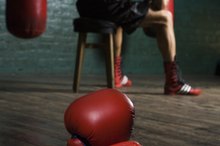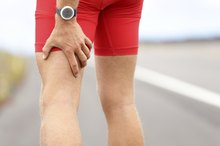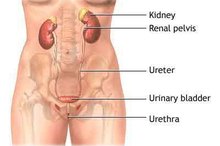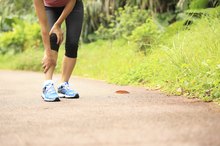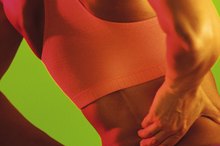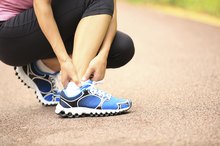Muscles Feeling Sore & Swollen After Workout
Experiencing sore muscles after a workout is not uncommon, but if your muscles swell, you might be concerned something is seriously wrong. In most cases, however, the swelling and pain are the result of delayed onset muscle soreness, which is not something that will ultimately harm your body. The symptoms of DOMS typically only last for three to five days, but can last up to seven to 10. If the pain and swelling don't start to dissipate three to four days after the initial onset, consult a doctor.
Symptoms and Features
The pain from DOMS typically sets in 24 to 48 hours after your workout is finished. It typically peaks between 48 and 72 hours afterwards, and can last up to seven days. Swelling will usually set in about the same time as the pain, but will peak three to four days after onset, lingering as long as 10 days. Other symptoms of DOMS can include stiffness, loss of strength and muscle tenderness. Beginners and more seasoned exercisers who push beyond their limits are more prone to getting DOMS; however, once endurance is built up, DOMS usually disappears and doesn't occur again until you increase the intensity of your workout.
- The pain from DOMS typically sets in 24 to 48 hours after your workout is finished.
- Swelling will usually set in about the same time as the pain, but will peak three to four days after onset, lingering as long as 10 days.
Causes of DOMS
Muscle Soreness After Boxing
Learn More
The exact cause of DOMS is not clear, but it is known that the pain and other symptoms result from an inflammatory response, possibly caused by microtears in the cells of the muscle. It has also been determined that eccentric exercise — resistance against the lengthening of the muscle — is the primary activity that leads to DOMS. Examples of eccentric exercise include running downhill or lowering a weight, such as when performing a leg or arm curl.
Treating Muscle Soreness
A consistent, effective treatment for DOMS has not been found, but taking some simple self-care measures may offer relief, according to the American Council on Exercise. Taking a hot bath or applying heat may help soothe the pain from DOMS. Massaging the muscles can also help the soreness, albeit only temporarily. Nonsteroidal anti-inflammatory drugs, such as ibuprofen, may help both the pain and swelling. Taking plant-based sitosterols and protease enzymes can help diminish the inflammation from DOMS, which may in turn reduce both the pain and swelling.
- A consistent, effective treatment for DOMS has not been found, but taking some simple self-care measures may offer relief, according to the American Council on Exercise.
- Massaging the muscles can also help the soreness, albeit only temporarily.
Preventing DOMS
How to Treat Severe Muscle Soreness From Weightlifting
Learn More
The most effective way to avoid the possibility of getting DOMS is by performing a warmup before your workout, according to researchers at the University of New Mexico. A warmup should include both a general warmup that warms your entire body and a more specific warmup that engages the muscles you will be using during your workout. For example, if you were going to lift weights to build your arm muscles, performing 10 minutes of mild cardio exercise, such as jogging, and then moving your arms the way you would during your workout without weights would be an effective overall warmup. Stretching your muscles before and after your workout may also help. If you are a beginner or a more seasoned athlete increasing the intensity of your workout, start slowly and gradually work your way up to more vigorous activity.
- The most effective way to avoid the possibility of getting DOMS is by performing a warmup before your workout, according to researchers at the University of New Mexico.
- A warmup should include both a general warmup that warms your entire body and a more specific warmup that engages the muscles you will be using during your workout.
Related Articles
References
- American Council on Exercise: Don't Be a Sore Loser
- University of New Mexico: Treating and Preventing DOMS
- Nosaka, Ken (2008). "Muscle Soreness and Damage and the Repeated-Bout Effect". In Tiidus, Peter M. Skeletal Muscle Damage and Repair. Human Kinetics. pp. 59â76.
- Michael Kjaer; Michael Krogsgaard; Peter Magnusson; Lars Engebretsen; Harald Roos; Timo Takala; Savio Woo (2008). Textbook of Sports Medicine: Basic Science and Clinical Aspects of Sports Injury and Physical Activity. John Wiley and Sons. p. 722.
- Armstrong, R. B. (1984). Mechanisms of exercise-induced delayed onset muscular soreness: a brief review. Medicine and Science in Sports and Exercise, 16(6), 529-538.
- Law, R. Y., & Herbert, R. D. (2007). Warm-up reduces delayed-onset muscle soreness but cool-down does not: a randomised controlled trial. Australian Journal of Physiotherapy, 53(2), 91-95.
- Cheatham, S. W., Kolber, M. J., Cain, M., & Lee, M. (2015). The Effects of SelfâMyofascial Release Using a Foam Roll or Roller Massager on Joint Range of Motion, Muscle Recovery, and Performance: A Systematic Review. International Journal of Sports Physical Therapy, 10(6), 827.
- Trappe, T. A., White, F., Lambert, C. P., Cesar, D., Hellerstein, M., & Evans, W. J. (2002). Effect of ibuprofen and acetaminophen on postexercise muscle protein synthesis.a> American Journal of Physiology-Endocrinology and Metabolism, 282(3), E551-E556.
- Schoenfeld, B. J. (2012). The Use of Nonsteroidal anti-inflammatory drugs for exercise-induced muscle damage. Sports Medicine, 42(12), 1017-1028.
- Knitter, A. E., Panton, L., Rathmacher, J. A., Petersen, A., & Sharp, R. (2000). Effects of beta-hydroxy-beta-methylbutyrate on muscle damage after a prolonged run. Journal of Applied Physiology, 89(4), 1340-1344.
- Innerfield, I. (1957). The AntiâInflammatory Effect Of Parenterally Administered Proteases. Annals of the New York Academy of Sciences, 68(1), 167-177.
- Miller, P. C., Bailey, S. P., Barnes, M. E., Derr, S. J., & Hall, E. E. (2004). The effects of protease supplementation on skeletal muscle function and DOMS following downhill running. Journal of Sports Sciences, 22(4), 365-372.
- Atal, C. K., Zutshi, U., & Rao, P. G. (1981). Scientific evidence on the role of Ayurvedic herbals on bioavailability of drugs. Journal of Ethnopharmacology, 4(2), 229-232.
- Velpandian, T., Jasuja, R., Bhardwaj, R. K., Jaiswal, J., & Gupta, S. K. (2001). Piperine in food: interference in the pharmacokinetics of phenytoin. European Journal of Drug Metabolism and Pharmacokinetics, 26(4), 241-247.
Writer Bio
Solomon Branch specializes in nutrition, health, acupuncture, herbal medicine and integrative medicine. He has a B.A. in English from George Mason University, as well as a master's degree in traditional Chinese medicine.
